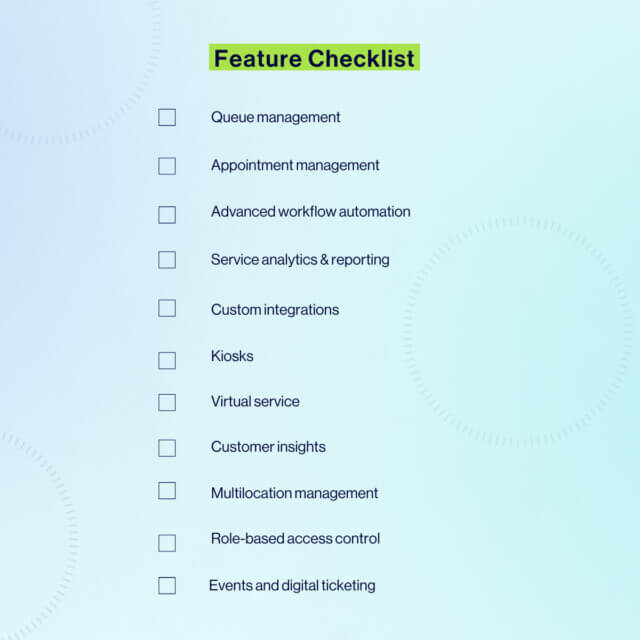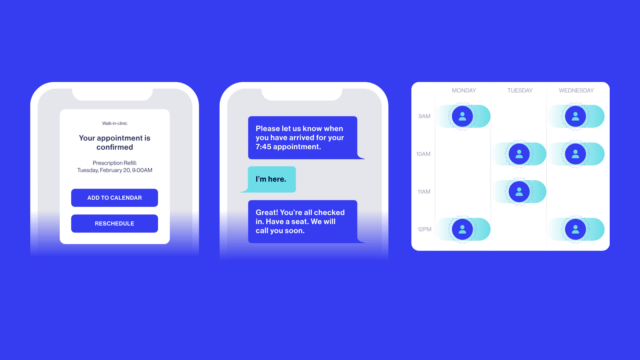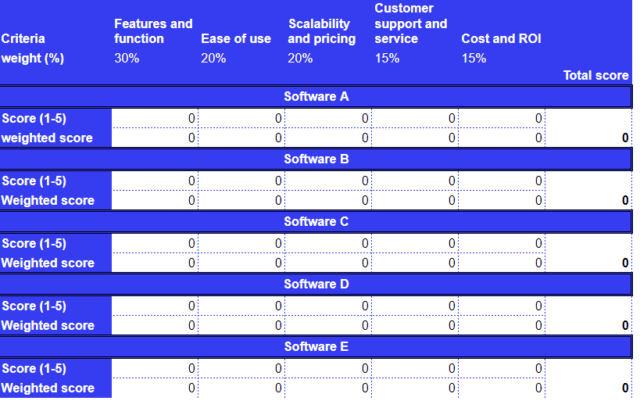
A comprehensive toolkit for your Queue Management Software search
Everything you need to know about selecting the right queue management software for your organization. From assessing your specific needs and understanding the core features to evaluating vendors.
Wole Olayinka • June 7, 2024 • Read time: 16 min

Queuing customers digitally at physical locations is table stakes for organizations that take customer experience seriously. Customer expectations for quick and efficient service are higher than ever. A well-implemented system reduces congestion and customer frustration while also providing real-time insight and data for customer service insights. Therefore, besides reducing wait times for customers, improving satisfaction and elevating service reputation, selecting the right software is also the key to boosting operational efficiency.
In this guide, you will discover everything you need to know about selecting the right queue management software for your organization. From assessing your specific needs and understanding the core features to evaluating vendors and integrating the system with your existing infrastructure, this comprehensive guide will equip you with the knowledge to make an informed decision.
→ Need a quick queue management software tour? Try our Interactive Demo!
Content
- How to understand your queue management software needs
- Important features to look for in queue management software
- Evaluation criteria
- Implementation and integration
How to understand your queue management software needs
The starting point in your queue management software search is understanding and defining your specific needs as thoroughly as possible. It’s often better to take proper assessments to ensure that you can effectively evaluate potential solutions based on how well they align with your requirements. No two queue management software are the same.
What aspects of queue management are most critical for your business? Is it reducing wait times, offering your customers convenience, or taking the stress off your staff? Reflect on your current challenges and objectives to determine your priorities in terms of features, pricing, and support.
For features, the main question revolves around the functionalities that are essential for your operations. Do you need basic queue management, or advanced capabilities like customer integrations, advanced workflow automation, or virtual service integration? Do you need two-way communication with customers in the queue? Understanding your must-have features will help you filter out solutions that don’t meet your basic needs.

Budget constraints should also play a significant role in decision-making. Determining your budget for queue management software, considering both initial costs and ongoing expenses ensures that you can be clear about your financial limitations and expectations to ensure you choose a solution that is both affordable and scalable for your organization.
Most importantly, customer support needs should be factored in as it greatly impacts the successful implementation and use of the software. Consider the level of support you might need, such as availability, training resources, and the quality of customer service. This ensures you have the necessary help to troubleshoot issues and maximize the software’s potential.
In case you are still not sure that you need a queuing solution, here are some common pain points that queue management software solves:
- Long wait times are causing customer dissatisfaction
- Crowded waiting areas
- Communication gaps between staff and customers
- Inefficiencies due to manual queue systems
- Difficulty managing increased customer flow
- Negative customer experiences affecting business reputation
- Lack of insights into customer flow and service reporting metrics
If you already have a solution, here are some common problems that drive organizations to switch their queue management software:
- The current system leads to bottlenecks and slow service
- Missing essential functionalities like real-time analytics or remote check-ins
- Complicated or unintuitive interface frustrating users
- Insufficient real-time, detailed, and exportable reports
- The system cannot handle increased customer volumes or additional service points/locations
- Lack of integration with other critical systems
- Inadequate security measures and non-compliance with regulations
- Unreliable support with slow response times and inadequate solutions
- Too expensive with hidden costs and low return on investment
- Outdated technology not keeping pace with advancements
Identifying your needs with all of the above in mind streamlines your search and focuses on solutions that best address your specific challenges and objectives. This targeted approach will help you find a queue management system that enhances efficiency, improves customer satisfaction, and supports your business growth.
→ Want a quick tour of queue management software? Try our Interactive Demo!
Important features to look for in queue management software
When searching for the ideal queue management software, evaluating key features that will best support your needs is paramount.
Queue management: A versatile queue management software should efficiently handle various queue types and queue control mechanisms, whether that’s a first-come-first-serve type queue or a priority-based one. It should support multiple ways to join a queue, enable numerous service types, and give your staff queue control mechanisms such as setting flexible hours and days for some queues or holding a customer’s place in a queue for a timeframe. You should also look for software that provides flexibility and adaptability to different scenarios and workflows. Picking the right solution makes all the difference; as noted by Ryan Bajaras, marketing manager at Langer’s Entertainment Centre in a review of WaitWell’s comprehensive queue management solution “It’s a better experience for the guests and it’s more income for us so it’s just a no-brainer. It’s a win-win for everyone.”
Appointment scheduling: Having an appointment scheduling feature working in sync with queue management can significantly enhance the staff and customer experience– it’s why a higher education user of WaitWell said “We love that the platform includes appointment booking and queuing all in one tool.” Check if the software allows for easy online booking, rescheduling, and cancellations. If you have multiple locations, does the software enable flexible multi-location appointment settings? Do you need pre-visit document uploads? Look for features like automated reminders via SMS or email to reduce no-shows and ensure smoother operations.

Workflow: Most queue management solutions claim to have workflow capacity in one form or another. However, effective workflow features need to be tailored to your unique services, locations, and business goals, to examine how the software manages workflow. Does it simplify processes, from customer check-in to service completion, and reduce manual staff intervention and errors? “WaitWell’s task automation is taking so much mental load off of our employees. Now they can just focus on doing their job,” said Bajaras of Langer’s. This is the point of workflow. A good workflow feature integrates seamlessly with your existing systems and automates routine tasks allowing staff to focus on providing actual service.
User interface and experience: The software should have an intuitive and user-friendly interface. A well-designed UI/UX ensures that both staff and customers can navigate the system effortlessly. Look for software that offers customization options to tailor the interface to your specific needs and branding. Ease of use is key to user adoption and successful rollout of the software.
Security and data privacy: With increasing concerns over data breaches and privacy, it’s crucial to choose a queue management system that prioritizes security. Ensure the software complies with relevant data protection regulations and implements comprehensive security measures such as encryption, user authentication, and regular security audits.
Reporting and analytics: An effective queue management software should provide comprehensive reporting and analytics capabilities. Look for real-time data insights on metrics like wait times, service times, and customer flow. The ability to export reports in usable formats is also essential for further analysis and sharing with stakeholders. These analytics can help you identify trends, optimize operations, and make >Interactive Demo!
Evaluation criteria
With needs clear and required features understood, the next step is reviewing the market’s offerings and shortlisting the best matching solutions.
Here are the top criteria to evaluate:
Features and functionality:
- Assess core features: queue management algorithms, appointment scheduling, workflow management, real-time reporting, and analytics.
- Evaluate integration with existing systems and customization options.
Ease of use:
- Ensure an intuitive, user-friendly interface for staff and customers.
- Evaluate the onboarding process and learning curve.
- Check if it simplifies queue management and enhances productivity.
Scalability and pricing:
- Ensure the software can grow with your business without performance issues.
- Evaluate the pricing model (subscription-based, one-time purchase) and alignment with your budget.
- Be aware of hidden costs for additional users or premium features.
Customer Support and Service:
- Assess the availability and quality of support options (support availability and channels).
- Check for training and resources.
Cost and ROI:
- Analyze the total cost of ownership: fees, implementation, and maintenance.
- Compare costs against potential ROI.
- Consider how the software can reduce wait times, improve customer satisfaction, and streamline operations.

→ Want a quick tour of queue management software? Try our Interactive Demo!
Implementation and integration
When your search is over, getting implementation right is key to avoiding wasted resources and disappointment. Proper planning and execution in this phase ensure a smooth transition and effective use of the new system.
Implementation planning: Start with a detailed implementation plan. Identify the key milestones, timelines, and responsibilities for each stage of the process. Ensure all stakeholders, including management, IT staff, and end-users, are involved in planning to address any concerns and streamline the implementation process.
Preparation and setup: Before rolling out the software, prepare your infrastructure to support the new system. This might include upgrading hardware, ensuring a stable internet connection, and testing compatibility with existing systems. A thorough setup of the software, including configuring user accounts, ensuring everyone has the right permissions, and customizing features to fit your business processes.
Training and onboarding: Effective training is critical for successfully adopting new software. Provide comprehensive training sessions for your staff, covering all aspects of the software from basic operations to advanced features. Ensure ongoing support is available to address any questions or issues that may arise during the initial usage phase.
Integration with existing systems: Test integrations and work with your IT team or the vendor to set up these connections properly. The importance of proper integrations cannot be overemphasized for data consistency and streamlined workflows.
Testing and feedback: Before full-scale deployment, conduct thorough testing of the software in a controlled environment. Identify any issues or bugs and work with the vendor to resolve them. Gather feedback from users during the testing phase to make necessary adjustments and improvements. This iterative approach helps in fine-tuning the system to meet your specific needs.
Go-live and monitoring: Once testing is complete and any issues have been resolved, proceed with the full-scale deployment of the software. Monitor the system closely during the initial go-live period to ensure everything operates smoothly. Be prepared to provide additional support and training to users as they become accustomed to the new system.
Ongoing support and maintenance: Post-implementation support is crucial for the long-term success of the software. Establish a maintenance schedule to keep the software updated and secure. Stay in regular contact with the vendor for updates, support, and any new features or enhancements that may benefit your business. Also, encourage users to provide ongoing feedback to continuously improve the system’s effectiveness.


